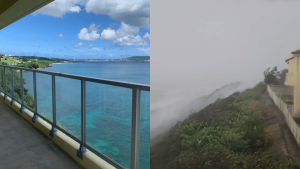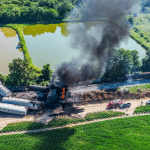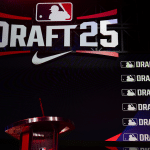Back in 2012, I packed up my things and moved to Mississippi from Monterey Bay, Calif. I had been stationed there for my final Army assignment at the historic and beautiful Army installation known as the Presidio of Monterey. After we stood and watched our last sunset over the Pacific Ocean as residents of Monterey, I brought my seven-month pregnant half-Mexican California girl I had recently married and a little boy who’d never seen much outside of the sun-drenched and dusty San Joaquin Valley to the Mississippi Gulf Coast.
The four-day drive across the country was an adventure I will never forget. My wife and I still have fun memories and inside jokes of our grand journey. When we arrived in Mississippi, my wife immediately fell in love with the lush green vegetation, the Mississippians and the food.
Within weeks of pulling into our new home in D’Iberville, I got a call from my boss. I had taken a job working in the public affairs shop of the Keesler Air Force Base’s 403rd Wing. The boss was telling me I was going to be scheduled to fly into my first hurricane with the 53rd Weather Reconnaissance Squadron, otherwise known as the Hurricane Hunters. Unfortunately, the forecasts were predicting the storm to make a path directly onto the Mississippi Gulf Coast. The local sages of D’Iberville were telling my wife that she would likely go into labor during the storm due to the barometric pressure change. Even though it was an old wive’s tale, she was terrified.
I talked it out with my boss and she allowed me to ride out the storm at home and she took the flight herself. I pleaded with her that my wife was scared and we moved here with no family nearby to take care of my wife if the worst should happen during the storm. I needed to be there.
Hurricane Isaac turned out to be a Cat 2 and was a massive rain event. Things turned out great and our first hurricane as a family ended up being an adventure that we look back on with fond memories. Luckily, we had a generator that powered the A/C. Otherwise, I think our memories would not have been as fond. Oh…and Cortney ended up not having the baby until a few weeks later.
Through the next few years, I flew countless storms with the Hurricane Hunters and the worst being Hurricane Rafael. It was midnight in the Bermuda Triangle.
Here is a recounting of the storm that almost killed me and forced me to consider a new career.
Hurricane Hunter vs. Hurricane Rafael
For a six-year Hurricane Hunter veteran in the 53rd Weather Reconnaissance Squadron, there is not much extreme flying that can put Lt. Col., Brad Boudreaux, on edge, but he nearly met his match during a mission flying Hurricane Rafael in the Bermuda Triangle on Oct. 15, 2013.
Boudreaux began his preflight routine like any other as he turned off the alarm on his phone and rolled out of bed. His goal for the day was to collect data for a strengthening Tropical Storm Rafael and to instruct Capt. Devon Meister, the newest pilot in the squadron, during what would be her first penetration into an eyeball of a hurricane.
“It all started off as a pretty routine day. Things didn’t start to get weird until we were flying toward the storm around sunset in the outer bands of the storm,” Boudreaux said.
In a C-130J simulator, when a pilot experiences a catastrophic failure of an aircraft, the screen is filled with a red glow letting the aircrew know that the plane has crashed. Boudreaux and Meister had seen this function known affectionately as the “red screen of death” numerous times in simulation, but as the sun was setting and filtering through the clouds, the red glow it cast reminded them of failed attempts in a simulator and set an uneasy feeling in the crew’s stomachs,” said Meister.
“It was like an omen. I remember seeing that red glow and thought that I don’t like to see that in simulation and definitely didn’t care for it in real life either. It was an eerie, creepy feeling,” said Boudreaux.
As the sky darkened to night, the hunters made their first pass through the storm with a bit of turbulence, lightning, and hail. Capt. Tobi Baker, an aerial reconnaissance weather officer on the flight noted that the winds had increased and the storm they were in had grown into a Category II storm.
“We had been getting reports that the storm was rapidly intensifying. These storms are always unstable and rough when they are getting stronger,” said Boudreaux.
Sometimes when the Hurricane Hunters are in a storm that is intensifying, they start getting some small and brief encounters with hail. During Rafael, the hail noise started getting really loud and that is when the hair on the back of my neck stood up because of the loud banging on the windscreen was right in front of my face, he said.
“You can’t help but wonder how strong is that piece of glass in front of my face being hit by marbles at 180knots,” questioned Boudreaux.
As if passing through a hail storm while flying through a hurricane at night over the Bermuda Triangle wasn’t enough, the crew began to also experience lightning.
“We had a lot of lightning. I am not talking about the heat lightning that just lights up clouds and is pretty, but actually striking bolts of lightning,” said Boudreaux.
One bolt hit Boudreaux’s aircraft on the left wing, which played havoc with electronics. “We got hit, immediately all of our comms went out and I was looking around trying to talk to the rest of the crew and no one could hear each other,” said Boudreaux.
Boudreaux sprang into action to solve the problem and immediately thought of a 110-volt circuit breaker. Once he pulled the breaker and reset it, everything came back to normal.
As an aircraft commander, anytime something happens like that, you have to assess the situation and find out if you have any systems that are degraded and any conditions that would preclude having a safe flight and returning home. Everything appeared normal and I felt comfortable that we could continue, said Boudreaux.
While approaching the eyewall with Meister at the controls, they began to experience rapid-fire lightning and very strong turbulence. The aircrew could see the intensity of the eyewall painted on the radar. The radar began showing severe precipitation indicators and extreme turbulence was flashing white all around them, said Boudreaux.
“We were getting roughed up pretty bad and Lt. Col. Kevin Green, the navigator for the mission, saw a section on the radar that looked like a large dry patch of air. We decided to fly toward that. Little did we know that it was a massive tornado-like weather pattern called a mesocyclone and that dry patch of air was actually a huge swirling vortex,” Boudreaux said.
Once Meister and Boudreaux began experiencing the strong erratic winds produced by the mesocyclone, the WC-130J began to stall and descend toward the churning Atlantic Ocean below. Sensing danger and realizing the limitations of Meister’s experience flying in these conditions had been reached, Boudreaux took control of the aircraft and sacrificed another 1,000 feet of altitude in order to gain enough airspeed to thwart the stall. Immediately Boudreaux piloted the aircraft to a safer location inside the hurricane and checked on the crew.
The crew recovered their bearings and continued the mission gaining valuable information for the National Hurricane Center’s forecast models. As a result of the radar data retrieved from their flight, weather officers and navigators in the Weather Reconnaissance Squadron now know additional information about the formation of mesocyclones and can take better actions to avoid them in future hurricane missions, said Boudreaux.
Fast forward ten years later, and my family was flying across the Pacific to our new home in Okinawa, Japan. Our first typhoon was also headed across the Pacific toward Okinawa. Let me tell you something about the difference between Mississippians and Okinawans when storms are headed this way. In 2012, Mississippians were still shellshocked as a society from storms like Hurricane Katrina that wreaked destruction, but the Japanese don’t pay much attention to typhoons and our flight from Tokyo to Naha passed directly through some feeder bands that gave us a wild ride. The rollercoaster-like turbulence reminded me of my time flying with the Hurricane Hunters.
We arrived at our new home and weathered the rest of the storm. Like I said in the last column, every animal in Okinawa is trying to kill you. We have huntsman spiders that are easily the size of a grown man’s outstretched hand. They can’t kill you, but can make you kill yourself falling over things to scramble away from them. My family had survived the Cat 2 Typhoon known as Hinnanmoor without any injury. It was another fun one for the books. Great memories and more fun inside jokes.
Once the worst of the storm was over, we ventured out into our new home. One thing about the excessive rain that typhoons bring, is the displacement of the Huntsman spiders. They come out to dry themselves off and find a fresh meal.
As we were venturing out post-typhoon, we hit up a place called Family Mart. Family Marts are a type of convenient store called Kombini’s. These are a staple of the Japanese economy. They have all sorts of good and cheap food. It’s not too bad for you either. They are like a miniature grocery store.
Visiting a Kombini was one of the first things on my family’s Japan “to-do” list. With an armload of snacks to take back to our hotel/typhoon bunker, I noticed the largest spider I had ever seen with my own eyes just chilling on the windowsill of the front of the Family Mart.
I calmly and casually pointed it out to my wife who is terrified of even the mention of a spider. In my defense, I had pointed out the spider in a calm manner because I thought it would be better for her to see it from a distance before she sauntered past it and happened to notice it up close…I was wrong. She bolted in the opposite direction of the spider. I was walking beside her and she ran through me like a Mississippi State linebacker and twisted her knee in the process.
We had survived numerous storms in Mississippi and now several in Okinawa with no injuries…but one spider sent her to the orthopedic doctor. Luckily the damage to her knee was just a sprain and tendonitis.
It has been 9 months since the spider incident, but all someone has to say is the word huntsman and my wife will run away. She was also terrified of the golden orb weavers in Mississippi as well.

At our one-year mark, we got hit with a wall of water. The storm’s winds were strong, but the houses built here are stronger. I live in the highest house on our cliff-side neighborhood. As I looked at the houses lower in elevation, I could see waves crashing against their house. I was terrified for my wonderful neighbors. I tried reaching them. Luckily they responded via text and said their houses were standing up to the wall of water crashing around them. My home didn’t have any damage from the winds, but as the winds dumped buckets of water, we had water intrusion on our windowsills and our balconies were filling up faster than bathtubs as the leaves blown from trees clogged up the drain.
Before long, my house was starting to slowly flood only on the 2nd floor. It felt like I was living in a leaky submarine for 24 hours. We used every dry towel in the house to soak up the water intrusion. I was also on one of our balconies that was flooding the worst to bail water and clear out the offensive leaves. The winds and water hit me and I felt like I was in real danger of being thrown from the balcony. It was a long night of survival, but I prevailed against the storm.
After the storm, Anna Taka, a Japanese/Okinawan friend of mine texted me to tell me that my experience is why Okinawans don’t live next to the water. Thanks, Anna. Duly noted. I guess there is an occasional price to pay for my wonderful view of the Okinawan coastline.







